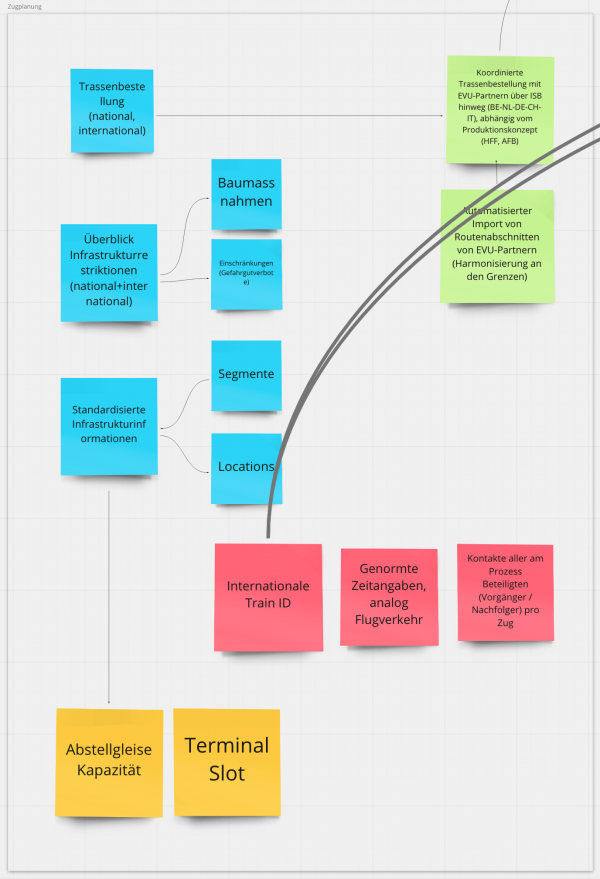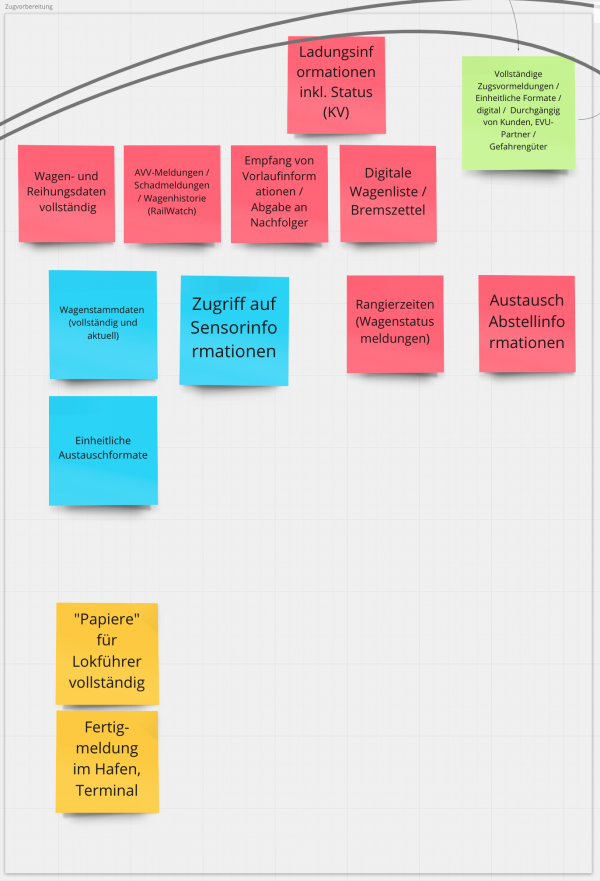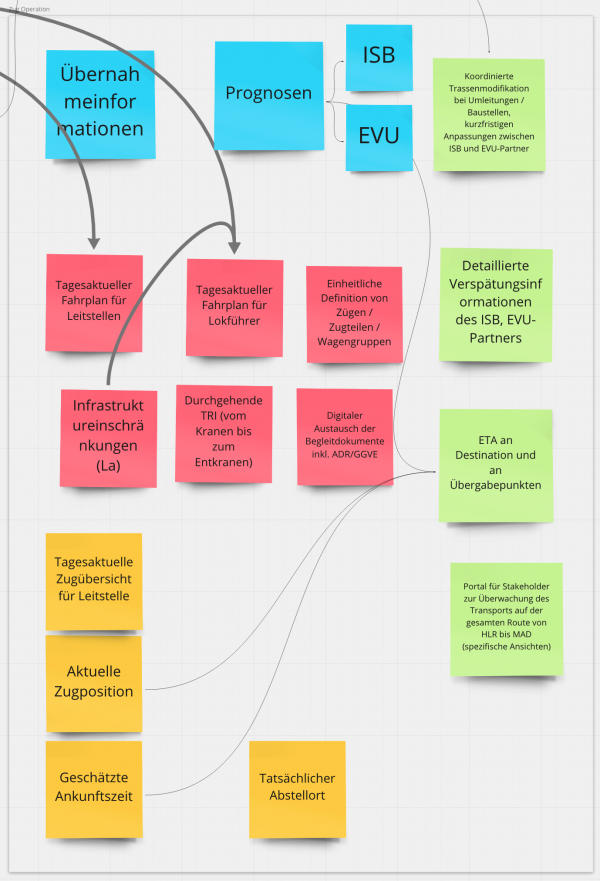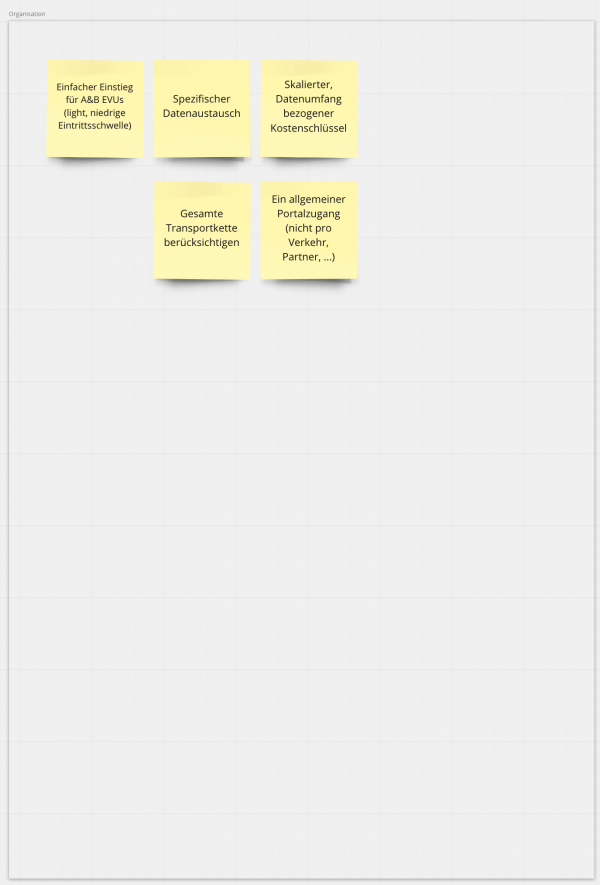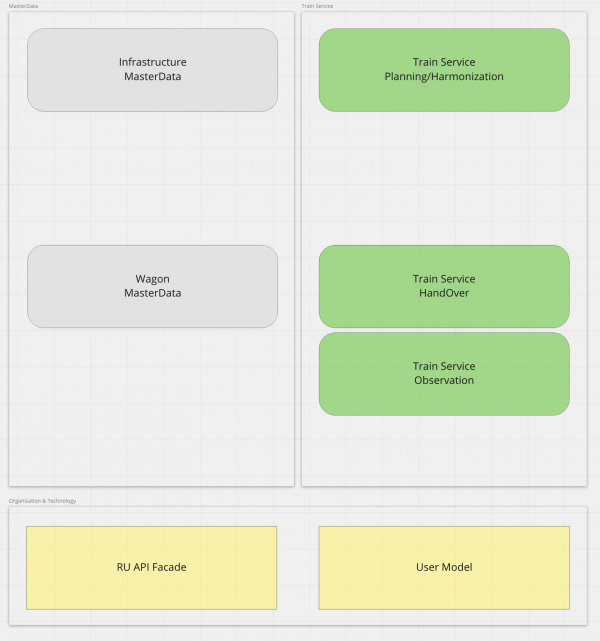DS DE1 GAP
From RFF Wiki
Contents
Organisation
The GAP Session was held on 6.July 14:30 to 16:30 with four participants
- Pascal Truniger BLS Cargo AG
- Martin Schmidt SBB Cargo International AG
- Markus Bürkl WHE
- Wolfgang Schüttler CN Consult
The SOLution Session is planned for end of August
GAP
Train Planning phase
The raised topics can be grouped into the RFF services:
- Train Service Harmonization
- Trassenbestellung (national, international)
- Koordinierte Trassenbestellung mit EVU-Partnern über ISB hinweg (BE-NL-DE-CH-IT), abhängig vom Produktionskonzept (HFF, AFB)
- Automatisierter Import von Routenabschnitten von EVU-Partnern (Harmonisierung an den Grenzen)
- Internationale Train ID
- Genormte Zeitangaben, analog Flugverkehr
- Kontakte aller am Prozess Beteiligten (Vorgänger / Nachfolger) pro Zug
- Terminal Slot
- Infrastructure masterdata
- CAP01 GEO: locations and segments
- Restrictions (CAPA XX)
- Standardisierte Infrastrukturinformationen: Locations und Segmente
- Überblick Infrastrukturrestriktionen (national+international): Baumassnahemn und Einschränkungen
- Abstellgleise Kapazität
Train Preparation phase
In the Preparation phase the raised topics are grouped to:
- Train Handover
- Ladungsinformationen inkl. Status (KV)
- Vollständige Zugsvormeldungen / Einheitliche Formate / digital / Durchgängig von Kunden, EVU-Partner / Gefahrengüter
- Wagen- und Reihungsdaten vollständig
- Empfang von Vorlaufinformationen / Abgabe an Nachfolger
- Digitale Wagenliste / Bremszettel
- Rangierzeiten (Wagenstatusmeldungen)
- Austausch Abstellinformationen
- Einheitliche Austauschformate
- Fertigmeldung im Hafen, Terminal
- "Papiere" für Lokführer vollständig
- Wagon masterdata
- AVV-Meldungen / Schadmeldungen / Wagenhistorie (RailWatch)
- Wagenstammdaten (vollständig und aktuell)
- Zugriff auf Sensorinformationen
Train Operation phase
The operational topics relate to the RFF services:
- Train Service Harmonization
- Tagesaktueller Fahrplan für Leitstellen
- Tagesaktueller Fahrplan für Lokführer
- Tagesaktuelle Zugübersicht für Leitstelle
- Einheitliche Definition von Zügen / Zugteilen / Wagengruppen
- Train Handover
- Übernahmeinformationen
- Digitaler Austausch der Begleitdokumente inkl. ADR/GGVE
- Tatsächlicher Abstellort
- Train Running Information
- Prognosen vom IM und EVU
- Detaillierte Verspätungsinformationen des ISB, EVU-Partners
- Durchgehende TRI (vom Kranen bis zum Entkranen)
- Portal für Stakeholder zur Überwachung des Transports auf der gesamten Route von HLR bis MAD (spezifische Ansichten)
- Aktuelle Zugposition
- Geschätzte Ankunftszeit
- ETA an Destination und an Übergabepunkten
- Infrastructure masterdata
- Infrastruktureinschränkungen (La)
Organisational Issues
In the round the need for
- an easy technical access and
- a light user model
are prerequisites to participate in the digital data exchange.
Summary
To summerize the above mentioned topics they concern the following services:
Infrastructure masterdata
- Reliable and uptodate information about nodes and segments (CAP01 GEO)
- Infrastructure restrictions: Network segment and node restrictions caused my planned/unplanned maintenance and incidents.
- Local information about nodes capacities and facilities
Wagon masterdata
- GCU messages concenring WagonDamage and WagonRepairHistory (RailWatch)
- Complete and uptodate technical wagon masterdata
- Access to sensor information on the wagon
Train Service planning
- Common understanding about train and its "components" (train, trainpart, wagongroup)
- Common train service planning (technical characteristics and timetable)
- Open information about train service plannning status
- International Train ID
- Standardized time information as in air traffic
- Contact information about all involved parties
- Planned terminal slot
- Aligned path request with RU partners across Infrstructure network borders (BE-NL-DE-CH-IT) depending on the role (contract holder, carrier)
- International and national Path request
- Automated import of neighbouring path segments for a common train service (Harmonisation at handover and interchange points)
- Operational timetable for operation centers
- Operational timetable for loco driver
- Accurate operational train information
Train Service HandOver
- Goods information including status (Combined Traffic)
- Complete, ontime train preadvice messages
- digital, standard format,
- throughgoing from customer and RU partner,
- dangerous goods
- Provisionig of omplete wagonlist
- digital
- Reception of status and forecast messages from previous partner
- Delivery of status and forecast messages to next partner in row
- Provisioning of Brakesheet
- digital
- Wagon status messages about shunting, delivery, provisioning
- Provisioning of parked units, wagons
- planned
- operational (real location)
- Provisioning of TrainReady messages from Port and Terminal operators
- Complete informationset for loco driver
- Handover information
- Digital exchange of train accompaning documentents incl ADR/GGVE
Train Service Monitoring
Train Running Information
- Accurate train forecast messages provided by IM
- Detailed delay information from IM and RU partner
- Throughgoing train running information (from slot to slot)
- Centralized portal for interested parties to monitor the transport along the whole route from HLR to MAD (with specific perspectives)
- Accurate train location
- Estimated time of arrival at
- HandOver points
- Interchange points and
- Destination
Technical and organisational issues
In the round the need for
- an easy technical access and
- a suitable (light) user model
are prerequisites to participate in the digital data exchange.
